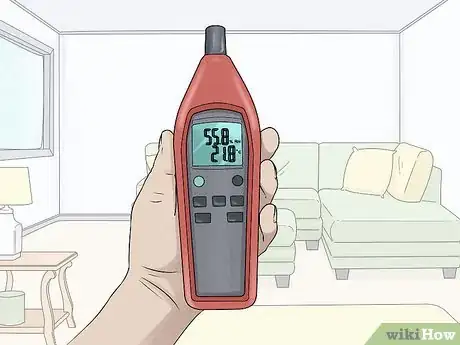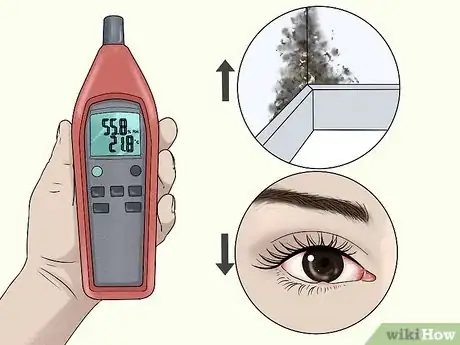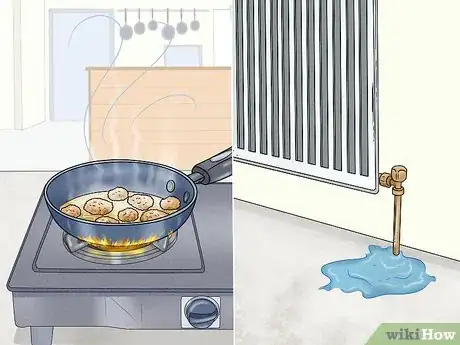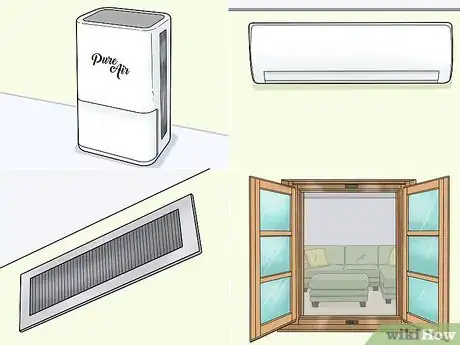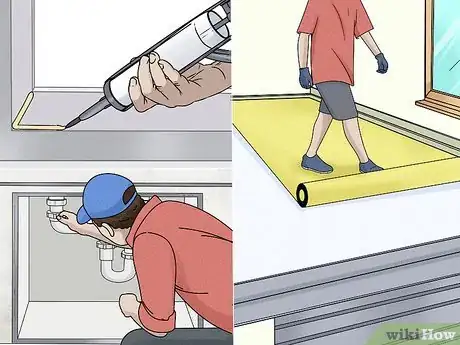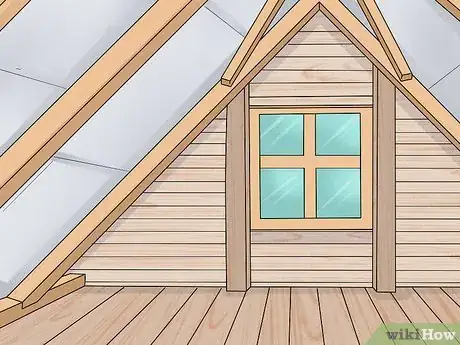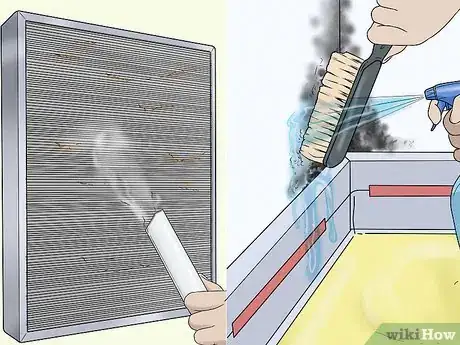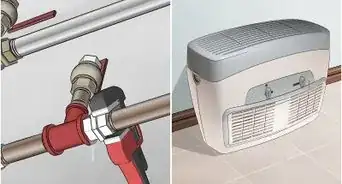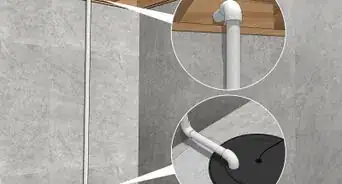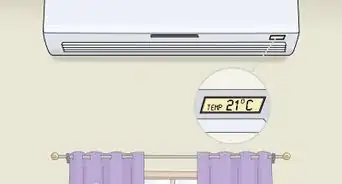This article was co-authored by Mike Kapur. Mike Kapur is a home inspector and the owner of Sonic Home Inspections, a home inspection company in Westchester, New York. With over 15 years of experience in pre-inspecting properties, Mike specializes in mold, radon, asbestos, lead, water, and air quality testing as well as hazardous materials, pest, infrared, and general home inspections. Prior to founding Sonic Home Inspections, Mike worked pre-inspecting apartments. Mike holds a BS in Accounting from Queens College and is a Certified Mold Assessor in the state of New York.
This article has been viewed 34,310 times.
Controlling humidity in your home is crucial to maintaining the overall health and comfort of your family and keeping your home safe against dangerous organisms like mold and mildew. If it always feels warm and musty inside your home, it could mean only one thing – the humidity level is higher than advisable.
Steps
Identifying a Moisture Problem
-
1Monitor the humidity level in your home. If your home seems damp and smells musty, it is almost certain that your humidity level is too high (above 60%). To assess the moisture level, you will need an accurate humidity meter (known as a hygrometer). If you do not have one, you can purchase a hygrometer at home improvement stores, big box stores, or online.
- You will need to measure the humidity level in various rooms in your home both while performing moisture-producing activities like showering, cooking, or doing laundry and shortly thereafter as the water is becoming more evenly distributed throughout your home.
- This will give you an idea of your home's "moisture profile."
-
2Keep an eye on your home’s humidity levels. The ideal range of humidity in homes is 40-60%.
- Humidity that is too high is not healthy. It negatively affects your health and can cause mold problems along with structural issues around your home.
- Humidity that is too low is not healthy either. Without enough moisture in the air, you are likely to feel mild to extreme discomfort, coupled with symptoms like chapped lips, sore eyes, difficulty in breathing, and painful sinuses.
- If your moisture level is too high, proceed with the remaining steps.
Advertisement -
3Identify the cause of high humidity. The first and most important step in controlling humidity is to determine the causes of moisture in your home. It could be any or a combination of the following:
- Poor ventilation. Indoor air quality is affected by how much fresh air enters your home and how much of the contaminated air is released outside. There are things that we do daily which significantly increase the moisture content of air inside our homes, such as showering, cooking, running the gas heater, drying laundry inside, etc. Without proper ventilation, humid air is trapped inside our dwelling, causing too much moisture in the air.
- Water leaks. Leaky pipes, roofs, and plumbing fixtures are all causes of excess moisture. As soon as you notice any sign of a leak, have it fixed right away.
- Wet materials or furnishings also contribute to high humidity. If your home has sustained water damage from flood or leaks, all surfaces and furniture affected must be dried completely.
Removing Moisture
-
1Ventilate rooms. Proper ventilation can be achieved in several ways:
- Install vents or exhaust fans especially in areas that create moisture a lot, such as the kitchen, bathroom, laundry room, and basement. You may also want to install fans in your attic.
- Or, open the windows and doors of your bathroom after showering, as well as the windows in your kitchen when cooking.
- Add a dehumidifier. A dehumidifier is an effective and inexpensive tool for controlling humidity levels inside a home or building. It works like a refrigerator, drawing moisture-filled air into a cold, 'refrigerated' coil. The damp air then condenses into water droplets which are collected in a water tank.
- Get an air purifier. It is an easy way to achieve healthy ventilation inside your home. Choose the one which fits the size of your dwelling.
-
2Make structural improvements. If you live in an old house, you are more likely to experience humidity problems due to common structural issues. For example, old buildings are usually built using porous materials which absorb moisture really fast, leading to mold and mildew build-up. Consider making adjustments and necessary repairs to your property.
- Install insulation around water pipes to help decrease ‘sweating’. Additionally, add waterproof insulation on toilet tanks.
- Install weather-stripping on your windows, caulk the frames, and ensure that the glazing is in good shape.
- Waterproof your home, including the basement.
- Clean and repair any problems with your roof, gutters, and downspouts. These are major sources of water damage. Loose shingles and flashing can cause water to infiltrate your attic, soffits, or wall cavities.
- During your next home renovation, ask your contractor about building materials that are less porous or less susceptible to moisture.
-
3Insulate your home. Especially in colder months, insulating your home not only helps you save on electricity, but is also vital to reducing humidity and condensation. Condensation happens when warm, moisture-laden air comes into contact with a cold surface, such as a glass. This may cause damage to interior paintwork, furnishings, floor coverings, and wall linings. Condensation can be controlled by reducing sources of humidity, by reducing sources of air infiltration, and by insulating your home, including the windows and doors.
-
4Clean your home and ensure everything’s dry. Cleaning is an effective way to spot moisture problems around your home. Incorporate these steps when cleaning:
- Clean or replace your HVAC filters regularly. Ensuring that your air conditioning and heating system is in good condition is essential to maintaining good air quality. The filters for your AC system and furnaces can get clogged with dust and other debris from time to time. Thus, regularly cleaning or changing filters is a must.
- Replace rugs and carpets if you notice that they are already moldy and smelling musty. These floor coverings collect moisture and can contribute to high humidity levels. If they are still in good condition, just have them cleaned and dried.
- If you already have mold problems at home, contact a remediation specialist to have it removed, your furnishings cleaned, and the source of the humidity fixed.
- When cleaning up after water damage, make use of tools that speed the drying process, such as air movers and air scrubbers.
References
About This Article
To remove moisture from the air quickly, you can increase ventilation by opening the windows and doors. Placing a dehumidifier or air purifier in the room is another simple way for you to control humidity levels and create healthy ventilation. You can also install vents or exhaust fans in areas that create a lot of moisture, such as the kitchen, bathroom, laundry room, and basement. For tips on weatherproofing and insulating your home to cut down on humidity, read on!
